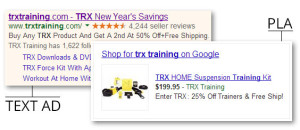Which Is Better For Your Ecommerce Marketing Campaigns, Text Ads Or PLAs?

Online retailers who have had a bad taste in their mouths ever since Google shifted from free-to-list product search to the paid environment of Google Shopping might want to take a look at how effective Google’s PLAs have proven to be. And while the initial reaction might be to compare PLAs vs. text ads (where it seems PLAs outperform brilliantly), what these statistics really show to the savvy online retailer is that a combination of both text ads and PLAs is the most effective way to increase your conversions.
Kenshoo’s Data
From 2011 to 2012, Kenshoo tracked the impressions, clicks, conversions and revenue of its own clients, using not just Google data but Bing, Yahoo, AOL and Baidu. What they learned is that eye-catching PLAs drew one and a half times the clickthrough rate of regular text ads, and converted 23% better, resulting in a 31% higher return on advertising spending (ROAS).
Those kinds of numbers make it likely that online retailers will want to flock toward a PLA approach to their online marketing, and for good reason. However, your text ads shouldn’t become a casualty of this change in direction. In fact, your text ads could prove to be the perfect complementary companion to your PLAs, which is why it’s important to use both of these marketing tactics effectively.
Google’s Data
Google recently conducted a study with Millward Brown Digital that suggested that consumers are far more engaged with brands and retailers who use both PLAs and a text ad, rather than consumers who only use text ads.
In fact, “far more likely” might be a bit of an understatement, in some cases. Take, for example the 90% increase in website visits, thanks to the PLA. But what good is a website visit if no conversion is made? Have no fear, since it appears that the increased number of visitors appear to be much more motivated to buy. There was an 83% increase in purchases made for retailers who used a combination of both text ads and PLAs vs. retailers who only used text ads.
But why are PLAs enjoying such impressive numbers? Studies show that PLAs specifically target the more motivated consumer. PLAs consist of graphics and pricing information, and clicking on these ads will lead buyers straight to the appropriate landing page to make a conversion. This is ideal for anyone who’s near the end of the buy cycle. But what about those who are at the start of the buy cycle, who are still researching and exploring?
With the addition of PLAs, the reality is that a large percentage of the SERP screen (like 80%) is dedicated to ads. It takes a great deal of mental effort to look past the ads on the screen to isolate the organic searches. This is where text ads come into play. Someone early on in the buy cycle might try to ignore PLAs because their images come across as “ad-like” vs. a simple text search result. Which is why online retailers have a second layer of support – the text ad. Text ads allow retailers to have more of a presence on the search engine results page, particularly if they don’t rank high organically for their search teams.
Of course, in the end, there’ll be consumers so early-on in the buy cycle that they’ll do their best to avoid anything that they assume is an ad. Anyone who is willing to scroll past all of the ads in order to reach the organic listings is certainly not in the mind frame of “buy now.” But, once they settle on their decision, and conduct a new search, they may see PLAs and text ads in a whole different light. Having caught glimpses of a retailer’s brand name or product could help increase the chances that when it’s time to convert, they’ll convert with you.
How should you use PLAs and text ads to your advantage? There’s a great deal of strategy at play. OperationROI can help. Call us at 1-888-277-5429 or fill out our contact form to find out how we can help you with your PLAs and text ads.







Surprise. Product Listing Ads (PLAs) drew one & a half times the clickthrough rate of regular text ads. #PLAs – http://t.co/HYqOwMwLyV
RT @OperationROI: Surprise. Product Listing Ads (PLAs) drew one & a half times the clickthrough rate of regular text ads. #PLAs
Which is better, Text Ads or Product Listing Ads (PLAs) for ecommerce websites? #PLAs #Adwords- http://t.co/9jswLgesTw
RT @OperationROI: Which is better, Text Ads or Product Listing Ads (PLAs) for ecommerce websites? #PLAs #Adwords- http://t.co/9jswLgesTw
Turn out using both Text Ads & PLAs is proving to be the most effective approach to increasing conversions & sales. – http://t.co/URtQyIaoo1
RT @OperationROI: Turn out using both Text Ads & PLAs is proving to be the most effective approach to increasing conversions & sales.